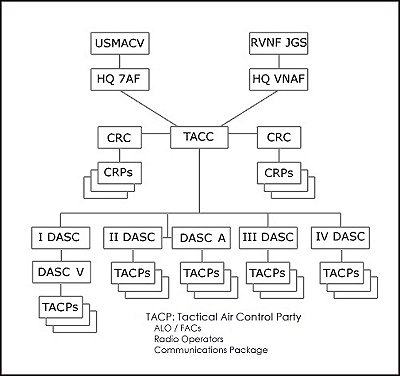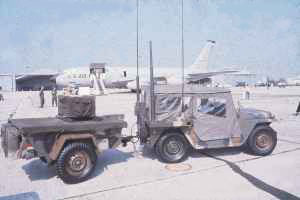
Home
FACs
More About FACs
The AO
A Shau Valley
• A Shau SF Camp
Hué
• Hué Cit Airfield
• MACV Compound
• LCU Ramp
• Hué Goose
Battle of Hué (Tet 1968)
• Trail FACs
The Missions
Visual Recon
• Sunken Sampan
Close Air Support
• CAS Munitions
• Rules of Engagement
• TACS
• Battle at Hua Cu
Interdiction
• McNamara Line
• Choke Points
Ranch Hand
Trail Dust Mission
Arc Light
SAR
Hammer 51 Rescue
Search for Jolly 23
• Msn Reports
• Search Area Map
• Search Rejoined
• Link to Past
Jungle Penetrator
Legacies
Aircraft
O-2A
Glossary
Resources
Contact
Return to Top
|

Tactical Air Control System
(TACS)

Tactical Air Control System major components in 1970
(Based on MACV Vietnam Lessons Learned No. 77)
| |
The Tactical Air Control System (TACS) was the means by which the senior Air Force commander in Southeast Asia was able to plan, direct and control tactical air operations and coordinate air operations with other services.
The TACS consisted of control agencies and communications - electronics facilities which provided the means for centralized control and decentralized execution of missions.
(7th AF Pamphlet 55-1, 1968)
The Tactical Air Control Systems epitomized the military's fascination with acronyms.
Hopefully this page will help to bring some sense to this alphabet soup.
Here are definitions of the more important terms.
Tactical Air Control Party (TACP):
As utilized in South Vietnam, a subordinate operational component of the
Tactical Air Control System designed to provide air liaison functions and
coordination for the control of aircraft; operates at corps, Field Force,
division, brigade or cavalry squadron, and battalion levels; may consist of
ALO's, FAC's, radio operators and equipment. (p. 16)
The Tactical Air Control Party (TACP) provides an Air Force communications
system down to the battalion level.
At the head of the team is an Air
Liaison Officer (ALO) who is a key member of the ground commander's staff.
The ALO attends the ground commander's meetings, briefs on air activity in
the area, and advises on the use and capabilities of tactical airpower.
Additionally, the ALO is a senior forward air controller and the supervisor
of the FACs in the TACP. These FACs are Air Force pilots who perform a
number of vital missions from their airborne positions in light observation
aircraft. They maintain close contact with local ground forces, help keep
ground units linked by providing timely airborne radio links, direct
airstrikes, forward Bomb Damage Assessment (BDA) reports, and perform
valuable visual reconnaissance during daily patrols of their sector. (p. 32)
The TACP's are located with the ground units down to the battalion level
and provide the link from the Army commander to the DASC [Direct Air
Support Center] for acquisition of supporting airpower. (pp. 35-36)
Direct Air Support Center (DASC):
A subordinate operational component of the Tactical Air Control System
designed for control and direction of close air support and other direct
air support operations; it is under the operational control of a tactical
air control or tactical air direction center and is normally located near
the command post of the supported ground unit. (p. 14)
Reference:
Seventh Air Force In Country Tactical Air Operations Handbook
7AF Pamphlet 55-1
Saigon: Headquarters Seventh Air Force, 20 March 1968
Links to additional information on the Tactical Air Control System:
Description of the Tactical Air Control System (TACS)
• TACS Areas of Responsibility (AOR)
• CAS Guide for Ground Commanders
Return to Top
|
|
|



